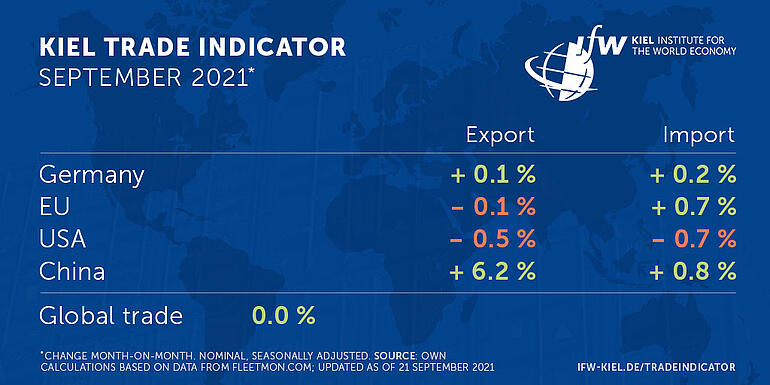News
Kiel Trade Indicator 09/2021: Global trade stagnates due to ongoing congestion at container ports

However, China itself seems to have found a way to overcome the closures of its terminals at the ports of Ningbo-Zhoushan and Yantian. Despite congestion off the Chinese coast, more goods were shipped from these ports and Shenzhen in the past four weeks than in the comparable period.
For China's exports in September, the Kiel Trade Indicator signals an increase of 6.2 percent compared to the previous month (nominal, seasonally adjusted), while for imports, with an indicator value of 0.8 percent, it signals a black zero.
World trade is expected to stagnate in September, with the indicator value at zero. The same is expected for Germany's trade (exports: +0.1 percent; imports: +0.2 percent). In the EU, exports are not expected to exceed the level of the previous month (-0.1 percent), while imports could be slightly higher (+0.7 percent). For the USA, the Kiel Trade Indicator shows slightly negative signs in both trade directions (exports: -0.5 percent; imports: -0.7 percent).
"The terminal closures in China are leaving their mark and dampening the exchange of goods. There are no signs of a sustained easing of the situation, which clouds the outlook for international trade. This is likely to be felt via rising prices and continuing shortages of certain goods, including in the Christmas trade," says Vincent Stamer, Head of Kiel Trade Indicator. "Christmas is not cancelled, but especially for products from China and Asia, missing deliveries or higher prices are to be expected."
Congestion off Ningbo-Zhoushan and Los Angeles currently ties up about 3 percent of global trade volumes in each of their main trade lanes. Cargo volumes in the Red Sea - the main sea trade route between China and Europe - are currently 14 percent lower than would be expected under normal circumstances.

For more information on the Kiel Trade Indicator and forecasts for 75 countries, visit www.ifw-kiel.de/tradeindicator.
The next update of the Kiel Trade Indicator will take place on October 5 (without press release) and on October 20 (with press release).
About the Kiel Trade Indicator
The Kiel Trade Indicator estimates trade flows (imports and exports) for 75 countries worldwide, the EU and world trade as a whole. It is based on the evaluation of ship movement data in real time. An algorithm programmed at the Kiel Institute uses artificial intelligence to analyze the data and translates the ship movements into nominal, seasonally adjusted growth figures compared with the previous month.
We update the data twice a month. Around the 20th (with press release) for the current and the following month and around the 3rd (without press release) for the previous and the current month.
Arriving and departing ships are recorded for 500 ports worldwide. In addition, ship movements in 100 maritime regions are analyzed and the effective utilization of container ships is derived from draught information. Country-port correlations can be used to generate forecasts, even for countries without their own deep-sea ports.
Compared to previous leading trade indicators, the Kiel Trade Indicator is available much earlier, is much more comprehensive, relies on a uniquely large database using big data, and has a low statistical error by comparison. The algorithm of the Kiel Trade Indicator uses machine learning, so that the quality of the forecast continues to improve over time.